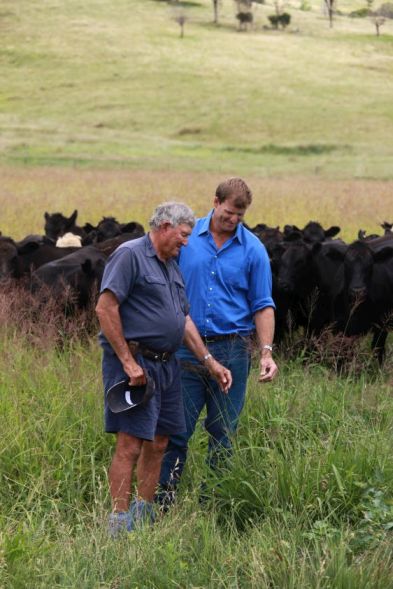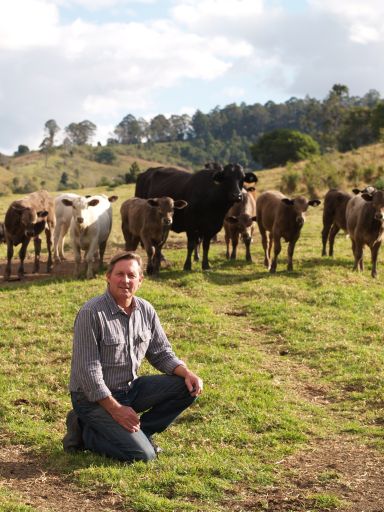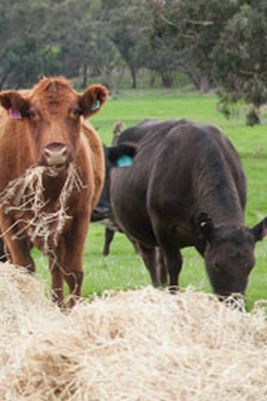- 1-Determine the stocking rate
- 2-Determine the grazing duration
- 3-Start grazing
- 4-Stop grazing
- 5-Rest Periods
- Module 3 Tools
- 3.01 - Pasture rulers,sticks and meters
- 3.02 - Setting pasture targets
- 3.03 - Pasture growth estimates
- 3.04 - Pasture utilisation
- 3.05 - Grazing management options
- 3.06 - Grazing management methods
3 - Pasture Utilisation

Key actions
- Increase green pasture consumed in a sustainable manner, the ideal percentage that can be sustainably consumed will depend on the environment and the enterprise.
- Base your grazing management on plant growth rate and growth stage for high quality and yield of pasture.
- Use tactical grazing techniques to meet different animal and pasture objectives at various times of the year.
- Manage pastures to ensure adequate rest and regrowth before the next grazing.
- Consider how feed is allocated within the herd to improve profitability. Strategic allocation of feed to sale classes of stock or young growing stock can have significant economic benefits and, once pasture utilisation has reached a sustainable level, can be used as another tool.
- Ensure that soil fertility is non limiting for your environment.
Why is efficient utilisation of green pasture important?

Aim to increase green pasture utilisation by 10% to raise productivity
This module focuses on the utilisation of high quality green pasture. Increasing the use of green pasture can be the most cost-effective way of lifting the productivity for the majority of beef enterprises.
Grazing managers should aim to convert the largest amount of pasture energy and nutrients into saleable beef while leaving pasture residue in the best condition for rapid regrowth. Precise control of grazing pressure and herd structure across a total grazed area can achieve utilisation of up to 60% of green pasture grown in areas where the summer dry period is relatively short and there is some green pick over summer. Examples of these areas are Western Victoria and South Gippsland. This level is higher than current industry estimates of 30–40% utilisation of total green pasture grown.
Sustainable utilisation targets of 40–48% are suitable for areas with an extended dry period greater than 150 days and very little summer feed on annual grass-based pastures or clover-based pastures.
The dairy industry is achieving pasture utilisation levels of 65–70%; however, dairy farms are generally located in a longer growing season zone or have irrigation and can supplementary feed with grain very easily.
In a beef situation, the cost of supplements (hay or grain) often comes directly off the bottom line and there is a significant period of little or no pasture growth. The level to which pasture utilisation can be improved in a beef enterprise depends on enterprise type (ie breeding herd versus trading enterprise), length of dry period and pasture type.
In a beef trading enterprise, pasture utilisation of 50–60% is possible in most environments, if limited stock are carried over the dry period.
In a breeding operation, a sustainable pasture utilisation of 40–55% is possible, depending on pasture type. Tables 1–4 works through an example of the amount of pasture required at the start of summer to maintain a given stocking rate.
The first point is to maximise the amount of pasture grown, allocate the feed to the correct livestock class and determine the level of utilisation that fits your environment and production system (trading versus breeding enterprise).
Summer feed budget example for North East Victoria (Reference: McPee. M.J., Ransom. K.P. and Oddy V.H. 1995. Calibration of emprical models: simulation of pasture growth and decay. Environmetrics 6: 505–510.)
Assumptions:
- summer starts on 1 December
- need 1,200kg of DM/ha at 1 May
- 150 days of summer
- 1kg DM/DSE/day.
Table 1: Summer pasture loss is influenced by pasture species
| Pasture type | Average rate of loss (kg DM/ha/day) |
| Clovers | 21 |
| Annual grasses | 13 |
| Perennial grasses | 7 |
Table 2: Effect of pasture type on feed utilisation
| Stocking rate (DSE/ha) | Feed consumed (kg) | Clover pasture | Annual grass pasture | Perennial grass pasture |
| 8 | 2,880 | 7,230 | 6,030 | 5,130 |
| 10 | 3,600 | 7,950 | 6,750 | 5,850 |
| 12 | 4,320 | 8,670 | 7,470 | 6,570 |
Table 3: Feed required at the start of summer
| Stocking rate (DSE/ha) | Clover pasture | Annual grass | Perennial grass |
| 8 | 5,550 | 4,350 | 3,450 |
| 10 | 5,850 | 4,650 | 3,750 |
| 12 | 6,150 | 4,950 | 4,050 |
Table 4: Pasture utilisation (%) taking into account stocking rate and type of pasture
| Stocking rate (DSE/ha) | Clover pasture (%) | Annual grass pasture (%) | Perennial grass pasture (%) |
| 8 | 40 | 48 | 56 |
| 10 | 45 | 53 | 62 |
| 12 | 50 | 58 | 66 |
In summary, perennial-based pastures have higher utilisation because they decay less over the summer. Increasing stocking rate – given soil fertility is adequate – increases pasture utilisation independently of pasture type. Having a perennial-based pasture also enables quicker pasture growth on opening rains compared to annuals starting from seed because the plant is already established.

Summer management of tropical grasses – applicable from Newcastle to Gympie along the NSW coast
Recent work undertaken by Tom Amey (producer) and Nathan Jennings (NSW Department of Primary Industries) demonstrated the benefit of slashing tropical grasses (in this case setaria) towards the end of summer if they have grown out of control. It is the same principle as removing the excess dry matter in southern Australia prior to the autumn break, to encourage good sub clover germination, but perhaps with even greater effect.
In the study, sertaria was slashed in late February in one section and compared to an unslashed area after 20 days, when digestibility, metabolisable energy and protein were measured. The slashed area (whole plants) had digestibility of 70%, metabolisable energy of 10.4 MJ/kg/DM and 21.9% crude protein. The unslashed area (whole plants) had digestibility of 55%, metabolisable energy of 7.0 MJ/kg/DM, and 7.8% crude protein.
When the same areas were assessed in September of the same year, the slashed area had 70% groundcover (clover) and the unslashed area had 10% clover. Using a grab technique to assess what stock were most likely to eat, the slashed area (whole plants) had digestibility of 70%, metabolisable energy of 10.4 MJ/kg/DM and 21.9% crude protein and the unslashed area had digestibility of 53%, metabolisable energy of 7.5 MJ/kg/DM and 8.0% crude protein. Table 5 shows pasture quality of setaria under two management techniques.
Table 5: Pasture quality of setaria under two management techniques
| Unslashed (whole plant) | Unslashed (leaf only) | Unslashed (stem only) | Slashed (whole plant) | Unslashed* | Slashed & white clover* | |
| Date sampled | 24/03/2011 | 24/03/2011 | 24/03/2011 | 24/03/2011 | 14/10/2011 | 14/10/2011 |
| Neutral detergent fibre (%) | 70 | 67 | 81 | 56 | 71 | 44 |
| Acid detergent fibre (%) | 43 | 38 | 46 | 31 | 43 | 25 |
| Crude protein (%) | 7.8 | 9.7 | < 2.0 | 21.9 | 8.0 | 22.7 |
| Digestibility (%) | 55 | 57 | 41 | 70 | 53 | 74 |
| Metabolisable energy (MJ/kg DM) | 7.0 | 8.1 | 5.4 | 10.4 | 7.5 | 11.2 |
| Yield (kg DM/ha) | 7,891 | 1,848 | 6,043 | 2,016 | 5,145 | 2,257 |
* Grab sample
This case study highlights that wherever your farming system, one of the keys is to divide the property into land classes (capability units) based on soil type and topography. The EverGraze program is a great example of 'plant for place' thinking in southern New South Wales, Victoria, Tasmania, south-east South Australia and southern Western Australia.
In the NSW coastal area from Newcastle to Gympie, management of summer tropical grasses is key to improving pasture quality. Combining this with the 'plant for place' principles gives great opportunities to grow everything from annual ryegrass, tropical grasses, white and red clover, and trailing vine legumes.
Better pasture utilisation increases pasture growth and quality
Intake of green pasture by cattle and subsequent beef productivity is influenced by the height, bulk density, total herbage mass per area and digestibility of the sward. Increasing utilisation can also improve pasture growth and quality, leading to better feed conversion efficiency, increased beef production per unit area and a decrease in unit cost.
The most important factor in improving profitability is identifying the stock numbers (stocking density or head/ha) that the enterprise is likely to sustain when utilisation of high quality (greater than 70% digestibility) green pasture is increased. Another key factor is to allocate the highest quality feed to the stock class that required the best quality feed (ie growing heifers, stock being finished for slaughter, or cows with young calves). High quality feed is wasted on dry pregnant cows in good condition. Focus on allocation of the feed base within the herd to optimise use (see Module 5: Weaner throughput for detail).
The number of animals (head/ha) will depend on the nature of the enterprise (breeding versus trading) but should be sufficient to ensure high utilisation of the pasture grown while maintaining the long-term sustainability of the pasture and the grazing system. To achieve an increase in pasture use, adopt a grazing management approach based on predicted seasonal plant growth patterns and the amount of residual feed required if carrying stock through the dry period.
Increase stocking rate and adopt a plant growth based approach to grazing management
- Graze enough animals to fully use available pasture without reducing animal intake below target requirements or grazing of new plant growing points.
- Ideally, time grazing to begin just before first leaf senescence (dying-off) occurs for desirable pasture species (refer to Module 2: Pasture growth, Tool 2.7, Figure 1) through autumn until mid-spring, then allow pasture to accumulate to the amount of feed required for your summer dry period in southern Australia.
- Monitor grazing and remove stock before critical limits for minimum pasture mass, height and groundcover are reached.
- Accurately assess the regrowth period before the next grazing occurs by monitoring pasture growth rates and the number of leaves per tiller through autumn until mid-spring.
- In areas where the growth is greater through the summer period, build a feed wedge before pasture growth slows.
A plant-based approach to grazing management ensures that pasture eaten by cattle during the growing season is of the highest possible nutritional quality (metabolic energy is greater than 11.5 MJ/kg DM), and allow the greatest opportunity for pasture regrowth after each grazing event.
Investment of time and capital is needed to intensify the grazing system in most beef enterprises. A grazing plan is essential for the progression of paddock sequences around the farm (see Procedure 1) to determine the level of investment that is operationally and economically justifiable. Careful management of less intensively grazed land using the same approach leads to further gains in productivity. The aim is for a sustainable and productive beef production system that maintains weed-free stable pastures and more than 70% groundcover on flat land and low slopes (100% on steep country) to reduce run-off, prevent erosion and improve the quality of water entering waterways.
Pasture mass limits
This module refers to various minimum and maximum limits for pasture mass (kg green DM/ha). It is important to understand the reasons for these variations.
- Pasture mass of 1,500kg green DM/ha is used as a minimum to maintain good conversion of pasture to beef.
- Grazing below this threshold, to a minimum of 1,000kg green DM/ha, will generally not harm the pasture or its potential rate of regrowth, but animal intake will start to be severely reduced. If a pasture is consistently kept below 1,000kg green DM/ha, persistence of the perennial pasture species will be reduced.
- At certain times of the year (eg autumn), good pasture management requires you to graze below 1,500kg DM/ha. In these cases, allocate animals that can tolerate low weight gain or loss of weight (eg dry or pregnant breeders). Under such circumstances, the stock may need to be supplementary fed.
How does this module assist you?
Application of the principles and procedures in this module, and use of the tools, will enable you to lift stock numbers and better manage green pasture utilisation on grazed land. This will increase your beef productivity (kilograms of beef per hectare) and decrease your unit cost of production (cents per kilogram of beef).
To achieve this you will need to:
- identify stock numbers (stocking density or head/ha) that the enterprise will sustain when green pasture utilisation is increased
- identify and monitor the most appropriate indicators to time the start of grazing
- stop grazing before pasture composition and groundcover are adversely affected
- use routine field measurements (pasture growth stage, mass and height) to estimate both the number of days’ rest required before the next graze and the amount of pasture mass available during the bulk of the growing season
- if summer dry periods are a feature of your production system, set targets to carry a certain stocking rate through the dry period as a base for pasture measurements from late spring onwards
- manage grazing pressure to ensure that planned and efficient use of available pasture mass and energy content is achieved before regrowth is grazed
- plan the best balance of animal performance and pasture regrowth by grouping and allocating cattle according to their nutritional requirements, and determining the grazing sequence and duration for grazing units across each pasture area
- set pasture and animal targets and precision-manage the grazing of all pasture zones to achieve production targets, maintain pastures and prevent soil and environmental degradation.
Linkages to other modules
This module has a pivotal relationship with Module 2: Pasture growth, Module 5: Weaner throughput and Module 7: Meeting market specifications. It also relies on information from Module 1: Setting directionsand Module 2: Pasture growth to forecast the grazing sequence (see Procedure 1 in this module) and rest period (see Procedure 5 in this module) for each grazing unit.
Principles of pasture utilisation
- Maximum cattle performance is achieved by managing the pasture to maintain 1,500–2,500kg green DM/ha.
- Pastures grazed in green leafy vegetative condition have the highest nutritional quality (ME > 11.5 MJ/kg DM).
- Animal intake and pasture quality decline when pasture mass exceeds 3,000kg green DM/ha.
- Maintaining pasture mass above 1,000kg green DM/ha promotes rapid growth and avoids overgrazing or patch grazing.
- If carrying stock over summer, building residual pasture above 3,000kg green DM/kg for most classes of stock will avoid supplementary feeding.
Procedures for maximising the efficiency of pasture utilisation
- Procedure 1 - Determine stocking rate
- Procedure 2 - Determine grazing duration
- Procedure 3 - Start grazing
- Procedure 4 - Stop grazing
- Procedure 5 - Rest periods
Note: these procedures assume a working knowledge of leaf emergence rates and the ability to estimate dry matter on offer. Such knowledge can be gained by undertaking a PROGRAZE course. Contact your state department of primary industries or agriculture for information about PROGRAZE in your state.

